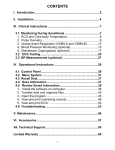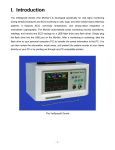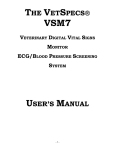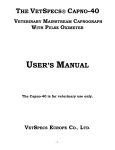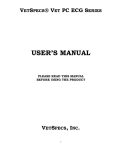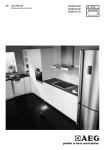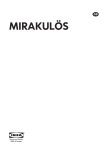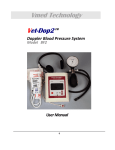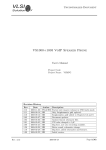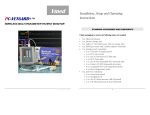Download VETSPECS USER`S MANUAL
Transcript
VETSPECS VSM8 VITAL SIGNS MONITOR USER’S MANUAL The VSM8 is for veterinary use only. VETSPECS, INC. www.vetspecs.com Contents I. Introduction ----------------------------------------------------------------- 1 II. Installation ------------------------------------------------------------------- 2 III. Clinical Instructions ------------------------------------------------------ 4 3.1 Monitoring in Anesthetized Patients ---------------------------------------- 4 1. ECG and Core-body Temperature ------------------------------------------------- 5 2. Pulse Oximetry -------------------------------------------------------------------------- 6 3. Blood Pressure Monitoring ----------------------------------------------------------- 9 4. Mainstream Capnography ---------------------------------------------------------- 14 3.2 ECG Testing ----------------------------------------------------------------------- 22 3.3 BP Measurements --------------------------------------------------------------- 24 IV. Operational Instructions ----------------------------------------------- 26 4.1 Control Panel --------------------------------------------------------------------- 27 4.2 Menu System ---------------------------------------------------------------------- 28 4.3 Recall Data ------------------------------------------------------------------------- 34 4.4 Save Information ----------------------------------------------------------------- 35 4.5 Review Saved Information ---------------------------------------------------- 36 1. Install the software on computer -------------------------------------------------- 36 2. Transfer data and organize files --------------------------------------------------- 37 3. View and print monitoring records ------------------------------------------------ 39 4. View and print ECG ------------------------------------------------------------------ 44 4.6 Troubleshooting ----------------------------------------------------------------- 46 V. Maintenance --------------------------------------------------------------- 49 VI. Customer Support ------------------------------------------------------- 50 Limited Warranty ---------------------------------------------------------------------- 51 I. Introduction The VetSpecs® VSM8 Vital Signs Monitor, the flagship model of VetSpecs® patient monitors, is developed specifically for monitoring during anesthesia, pre-anesthetic ECG testing, and clinical blood pressure measurements in cats, dogs, and other similarsized veterinary patients. Featuring state-of-the-art VetSpecs ® proprietary technologies, the VSM8 offers the capability of comprehensive monitoring for patients under anesthesia. It monitors patients’ ventilation with mainstream capnography, circulation with noninvasive blood pressure, oxygenation with pulse oximetry, and ECG and core-body temperature with an esophageal probe. The VSM8 automatically saves monitoring records (waveforms, readings, and trends), ECG tracings, and blood pressure readings on a USB flash drive for easy transfer of data to computers. You can then review the saved information, print reports through your office laser or ink-jet printers on 8.5”X11” plain papers. The VSM8 exemplifies VetSpecs’ devotion to developing effective, easy-to-use, and reliable products to support veterinarians’ efforts in providing excellent care while building successful practices. -1- II. Installation 1. The Module The VSM8 comes with a multi-parameter module (hereinafter “the Module”). Connect the Module to the light gray port on the right side of the monitor. The monitor displays MODULE OFF in the HR area (green), SpO2 area (red), and RR area (yellow) when the Module is not connected to the monitor. Upon connecting the Module to the monitor, MODULE OFF in all three areas go away. 2. Esophageal Probes The VSM8 comes with a set of two esophageal probes. The one labeled Esophageal Probe for Cats is for use in cats and some small dogs. The one labeled Esophageal Probe for Dogs is for use in dogs. For monitoring ECG and temperature in anesthetized patients, connect an esophageal probe to the GREEN port of the Module. LEAD OFF goes away when the probe is inserted into the patient. 3. ECG Leads with Flat Clips The VSM8 comes with a set of ECG leads with flat clips (green, red, and white). For ECG testing, connect the ECG leads to the GREEN port of the Module. LEAD OFF goes away when all three leads are applied onto the patient. 4. SpO2 Sensor The VSM8 comes with a SpO2 lingual sensor (gray clip). Connect the SpO2 sensor to the RED port of the Module. PROBE OFF goes away when the SpO2 sensor is connected to the Module. -2- 5. Mainstream CO2 Sensor The VSM8 comes with a mainstream CO2 sensor. Connect the CO2 sensor to the YELLOW port of the Module. The monitor displays MODULE OFF in the CO2 area (yellow) when the CO2 sensor is not connected to the Module. Upon connecting the CO2 sensor to the Module, the monitor displays CAL and CO2 CALIBRATION. 6. NIBP Module and Accessories The noninvasive blood pressure (NIBP) capability of the VSM8 consists of a NIBP module, a pulse sensor band (with a long black Velcro strip), and a set of five cuffs. Connect the NIBP module to the BP port (Gray) on the right side of the monitor. The monitor displays MODULE OFF in the NIBP area (blue) when the NIBP module is not connected to the monitor. Upon connecting the NIBP module to the monitor, MODULE OFF goes away. The pulse sensor band is to be connected to the NIBP module. Upon connecting the pulse sensor band, a blue bar graph appears in the NIBP area. When the pulse sensor band is not applied to the patient, the monitor may flash BP SENSOR OFF. The cuffs are to be connected to the tube on the NIBP module. 7. USB Flash Drive The VSM8 includes a USB flash drive. Connect the flash drive to the USB port on the back of the monitor. The monitor displays DISK:None at the bottom of the screen when the flash drive is not plugged in, and DISK:Ready when the flash drive is plugged in. 8. Power Cord Connect the included power cord to the black power port at the back of the unit and to a standard 3-line power outlet. -3- III. Clinical Instructions 3.1 Monitoring in Anesthetized Patients The VSM8 features three work modes: monitoring mode, ECG mode, and blood pressure mode. The VSM8 automatically switches to monitoring mode when an esophageal probe is inserted into the patient, i.e. a temperature is registered, or the CO2 sensor is connected to the Module. In monitoring mode, the VSM8 displays cascaded two lines of ECG (green), one line of pulse waveforms (red), and one line of CO2 waveforms (yellow). Monitoring mode -4- 1. ECG and Core-body Temperature The VSM8 registers ECG, heart rate (HR), and core-body temperature in anesthetized patients with an esophageal probe. (1) The esophageal probes Generally speaking, the esophageal probe labeled for Dogs is for use in dogs, while the esophageal probe labeled for Cats is for use in cats and some small dogs. An esophageal probe for small kittens, rodents, and lizards is also available as optional. In order for the esophageal probe to register ECG, all three metal rings must establish good and stable contacts with the esophagus. If the metal rings are too small to do so, the esophageal probe may produce erratic ECG tracings and inaccurate HR. Thus, the probe for Cats should not be used in medium or large dogs. (2) Apply the esophageal probe After the patient has been anesthetized and intubated, estimate how deep to insert by laying the probe on the patient. The distal ring and middle ring should be positioned across the heart after inserted. Mark the probe at the mouth level with your hand, and then slide the probe into the esophagus to the estimated depth. Watch the screen. If ECG is erratic, adjust the depth of the probe until stable ECG tracings are registered. Motions induced to the patient and/or the probe may produce motion artifacts on the ECG tracings. Tie the probe to the endotracheal tube to minimize motions if necessary. When using the esophageal probes in electrosurgery, the patient must be properly grounded as instructed in the User’s Manual for the electrosurgical unit being used. Never insert a probe into a patient which is not anesthetized. Do not use a probe which is damaged externally. -5- 2. Pulse Oximetry The VSM8 comes standard with a SpO2 lingual sensor (gray clip). A SpO2 leg/toe sensor and a SpO2 rectal probe are also available as optional. (1) SpO2 Lingual Sensor The lingual sensor is intended for use on the tongue only, not at any other places on the patient. Place the sensor at the center of the tongue with the light-emitting side on top of the tongue, not at the edge of the tongue. For a thin tongue, such as the tongue of cats and some small dogs, it is highly recommended to put two pieces of dry gauze on the tongue, one on each side, and then clip the lingual sensor on the gauze. (2) SpO2 Leg/toe Sensor (optional) Use the leg/toe sensor (blue clip) only when the lingual sensor is not suitable for the procedure, for example, in dentistry. For cats, place the leg/toe sensor at one of these sites: On the distal leg between the carpal pad and the metacarpal pad, see Sketch 1. If the sensor site is covered with dark hair, clip the hair on both sides of the leg. On the paw with the light-emitting side on top of the paw and the other side of the sensor on top of the metacarpal pad, see Sketch 2. For dogs, place the leg/toe sensor at one of these sites: On the Achilles tendon, see Sketch 3. On a toe side to side, see Sketch 4. If possible, apply the sensor to a toe with light skin. For a toe covered with dark hair, clip the hair on both sides. On the distal leg between the carpal pad and metacarpal pad, see Sketch 1. On a skin fold at the lower belly, the prepuce, or the vulva, if appropriate. Do not place the leg/toe sensor on the tongue, except for equine patients. Applying the leg/toe sensor on the tongue of cats or dogs may cause vasoconstriction. -6- Sketch 1: The Leg/toe sensor on the distal leg of cats or small dogs. Sketch 2: The leg/toe sensor on a paw of cats. Sketch 3: The leg/toe sensor on the Achilles tendon of dogs. Sketch 4: The leg/toe sensor on a toe of dogs. -7- (3) Watch the waveforms Each time when the sensor is applied onto the patient, the monitor will automatically start to calibrate the sensor. The calibration process takes about 15 – 20 seconds. After the calibration, a line of pulse waveforms (red) and a red pulsating bar graph are displayed. The waveforms and the bar graph pulsate in synch with the heartbeats when the sensor is picking up valid arterial pulsations. The SpO2 reading is accurate only when the waveforms and the bar graph are pulsating in synch with the heartbeats. After applying the lingual sensor, if the waveforms are erratic or a flat line, the tissue underneath may be in a low perfusion condition. Some anesthetic agents produce low perfusion on the tongue. For cats and small dogs, it is recommended to place two pieces of dry gauze on the tongue, one on each side, and then clip the sensor on the gauze. This may improve perfusion in the tissue by reducing the pressure build-up. If the waveforms become erratic during the monitoring, verify the patient status, and move the sensor to another spot on the tongue. After the sensor has been placed on one spot for an extended period of time, the effect of the pressure could build up to cause vasoconstriction in the tissue. When using the leg/toe sensor, always place the sensor at a site with light skin if possible. To apply to a site with pigmented tissue, the hair on both sides must be clipped. Watch the waveforms. If the waveforms are a flat line or pulsating intermittently (the bar graph is barely moving), the site is too pigmented to permit adequate light transmission. Try another site. When both the SpO2 channel and the ECG channel are working properly, the pulse waveforms and the ECG are in synch with each other. If they are not in synch with each other, a red flashing question mark (?) will appear near the heart rate, indicating one or both channels are not working properly. Verify the patient status and sensor placement. If necessary, adjust the placement of the SpO2 sensor or the esophageal probe. The red flashing question mark (?) will stay on the screen until the pulse waveforms and the ECG are in synch with each other again. -8- 3. Blood Pressure Monitoring (1) The technology Blood pressure (BP) is the lateral force per unit area exerted on a vessel wall. The pressure generated is pulsatile and creates a wave of vascular distention. This forwardmoving pressure wave has maximum (systolic arterial pressure) and minimum (diastolic arterial pressure) values oscillating around a mean value (mean arterial pressure), which is the average pressure throughout the cardiac cycle that pushes blood through the vascular network. Since systole is normally shorter than diastole, mean arterial pressure (MAP) is not simply the midpoint between systolic arterial pressure (SAP) and diastolic arterial pressure (DAP) but is estimated as MAP = DAP + (SAP - DAP) 3 The VSM8 offers a breakthrough noninvasive blood pressure method, called volume plethysmographic method, which employs an inflatable cuff to occlude arterial flow and a sensor band to sense arterial pulsations. The VSM8 registers SAP, DAP, and MAP and a real-time pulse rate (PR) in each measurement, and with push of a button, provides the averaged readings for all the measurements. (2) Choose an appropriately sized cuff The VSM8 comes with a set of different sized cuffs for use in cats and dogs of all sizes. All cuffs are marked to aid in proper cuff selection. When a cuff is wrapped around a site, its index edge should be within the range indicated on the cuff. The cuff is too small or too large if the index edge is outside the range. The following should be used only as general guidelines for cuff selections, because the circumference of the site, not the size of the patient, determines which cuff to use. The smallest cuff is for kittens and very small dogs. The second smallest cuff is for cats and small dogs. The third largest cuff is for medium dogs. The second largest cuff is for medium to large dogs. The largest cuff is for large dogs. A cuff that is too narrow will produce artificially elevated readings, while a cuff that is too wide will produce spuriously low values. -9- (3) Apply the cuff and the sensor band Apply the cuff and the sensor band to the same limb or the tail of the patient. The sensor band must be placed below (distal to) the cuff, about half of an inch away from the cuff. Place the sensor band over a main artery with the side labeled SENSOR BAND facing out. It is not necessary to clip the hair anywhere. Place the long Velcro strip though the metal buckle on the sensor band, pull the strip back to wrap the sensor band tight, and then wrap the strip completely around the sensor site. Do not leave a portion of the strip unwrapped, because motions may be induced to the sensor through the unwrapped strip, disrupting the measurements. The sensor band may not work effectively if it is not wrapped and positioned correctly. The recommended cuff and sensor placements are listed below: Place the cuff at the base of the tail and the sensor band half of an inch below the cuff. Position the sensor band over the median coccygeal artery, see sketch 5. The tail placement is recommended for patients with short legs and for conscious patients, especially cats. Cats tolerate much better the tail placement. For cats or dogs with long hind legs, the cuff may be placed below the hock and the sensor band half of an inch distal to the cuff. If the cuff is placed on the Achilles tendon and the sensor band below the hock, you need to verify if the cuff can occlude the arterial flow properly when inflated (see page 13 for more instructions). Place the cuff and the sensor band between the elbow and the carpus, see sketch 6. Lay the patient in lateral recumbence to minimize the effect of gravity. Conscious cats usually do not tolerate well the foreleg placement. If a site is too small to allow the sensor band to be wrapped properly tight, try another site with a larger circumference. In order for the cuff to occlude the arterial flow when inflated, the cuff must be placed at an appropriate site. Do not place the cuff on the hock or elbow. If the cuff is placed on a joint, or too high on a limb, it may not be able to completely occlude the arterial flow when inflated, producing erroneous readings. - 10 - Sketch 5: Place the cuff at the base of the tail and the sensor band half of an inch below the cuff. Position the sensor band over the median coccygeal artery. Pull the Velcro strip to wrap the sensor band tight. Wrap the strip around the sensor site until it is completely wrapped up. Do not leave the strip unwrapped. Sketch 6: Place the cuff and the sensor band between the elbow and the carpus, with the sensor band half of an inch to one inch distal to the cuff. Pull the Velcro strip to wrap the sensor band tight. Wrap the strip around the sensor site until it is completely wrapped up. Do not leave the strip unwrapped. Lay the patient in lateral recumbence to minimize the effect of gravity. - 11 - (4) Watch the bar graph The VSM8 displays a systolic arterial pressure (S), diastolic arterial pressure (D), mean arterial pressure (M), and a real-time pulse rate (PR). Measurement interval (INT.) is also displayed on the screen. The arterial pulsations registered by the sensor band are displayed as a pulsating bar graph (blue). After applying the cuff and the sensor band, watch the bar graph. The bar graph pulsates in synch with the heartbeats when the sensor band is picking up valid arterial pulsations. If the bar graph is jumping erratically, the sensor band is picking up motions. In order to perform BP measurements, a valid PR has to be registered first. When the sensor band is picking up valid arterial pulsations, a PR will be registered in seconds, and at the same time the monitor will display READY, indicating it is ready for BP measurements. The monitor will be displaying WAIT… until a valid PR is registered. No BP measurements can be started before READY is displayed. If the bar graph is erratic (not in synch with the heartbeats), there are repetitive motions being induced to the patient, or the sensor band is not working properly. Test the sensor band on your finger by wrapping it on your index or middle finger. If the bar graph pulsates vigorously and in synch with your heartbeats, the sensor band is good. Try it again on the patient. If the bar graph is erratic on your finger, the sensor band may need to be replaced. When the NIBP module registers no signals, the VSM8 will flash BP SENSOR OFF, indicating one of the three situations: (1) the sensor band is not connected to the NIBP module; (2) the sensor band is not applied to the patient; or (3) the sensor band was worn out. If the monitor flashes BP SENSOR OFF while the sensor band is applied on the patient, tap the sensor band with your finger. If BP SENSOR OFF does not go away, the sensor band needs to be replaced. - 12 - (5) Start a measurement BP measurements can be started manually or automatically at a user-set interval. To manually start a measurement, push START/STOP key while READY is displayed. The VSM8 rapidly inflates the cuff to around 280 mmHg, and then deflates gradually. The real-time cuff pressure count down is displayed in the NIBP area. The deflation process takes only a few seconds. The bar graph will resume pulsating when the pressure inside the cuff equals the systolic arterial pressure, indicating the return of arterial flow. Upon completing the measurement, systolic, diastolic, and mean arterial pressure readings are displayed. The time at which the measurement was completed is also displayed. Between measurements, if motions are induced to the patient, the monitor may display WAIT… until the sensor band is again picking up valid arterial pulsations. If pushing START/STOP key while WAIT… is still displayed, a measurement will not be started until READY is again displayed. To abort a measurement, push START/STOP key. The bar graph should stop pulsating immediately after the cuff inflation, indicating the occlusion of the arterial flow. If the bar graph keeps pulsating immediately after the cuff inflation, indicating a failure to occlude the arterial flow, no BP readings will be registered, and OCCLUSION FAILED will be flashing on the screen. If OCCLUSION FAILED is displayed, verify the cuff placement and size. Make sure that (1) the cuff is applied correctly, (2) the cuff is placed at an appropriate site, and (3) the cuff size is appropriate for the site. The monitor will keep flashing OCCLUSION FAILED until READY is displayed again. It is highly recommended to manually start the first measurement and watch the entire measurement process closely. Set the monitor to automatically perform BP measurements only after you have confirmed that the cuff can successfully occlude the arterial flow. - 13 - 4. Mainstream Capnography (1) The concept Capnography is measurement and waveform display of CO2 concentration at the patient’s airway. It monitors various components of patient and anesthesia circuit/equipment as well as the critical connection between the two. A capnogram is the graphical waveform depicting CO2 concentration throughout respiration. End-tidal CO2 (ETCO2), which can be expressed as mmHg or percentage, refers to the measurement of CO2 concentration at the end of exhalation. The normal range of ETCO2 for most mammals is 25 – 45 mmHg or 3.5 – 5.5%. It is considered to be abnormal when the ETCO2 is higher than 50 mmHg (or 6.5%) or lower than 20 mmHg (or 2.5%). The diagram below shows the shape of a normal capnogram. Phase I: A near zero baseline — Exhalation of CO2-free gas contained in dead space. Phase II: Rapid, sharp rise — Exhalation of mixed dead space and alveolar gas. Phase III: Alveolar plateau — Exhalation of mostly alveolar gas. At the end of exhalation, CO2 concentration reaches the peak - end-tidal CO2 value. Phase 0: Rapid, sharp down-stroke — Inhalation. VetSpecs® mainstream capnography provides real-time CO2 waveforms, an ETCO2 reading, a RR, and a digital respiratory sound. Unlike side-stream or micro-stream capnography, mainstream capnography performs CO2 measurements directly inside the airway, withdrawing no gas away from the airway. - 14 - (2) Clinical implications Normal ETCO2 readings, together with a normal capnogram, indicate normal function of the patient’s metabolism, circulation, and ventilation, and of the anesthesia machine. Increases in ETCO2 may be due to anesthetic induced respiratory depression, increased metabolism, or the addition of CO2 to the circulatory system as a result of rebreathing CO2. Re-breathing CO2 can be due to soda lime exhaustion or incompetent expiratory valve on the anesthesia machine allowing exhaled CO2 to be re-inhaled. Decreased or abolished ETCO2 may be due to hyperventilation, low cardiac output, respiratory arrest, or cardiac arrest. Capnogram also provides vital information regarding the patient's airway potency. A depressed or absent capnogram may be due to a dislodged, misplaced, or obstructed endotracheal tube or airway, a leak around endotracheal tube cuff, or disconnection of the endotracheal tube from the anesthetic machine. The following are some examples of abnormal capnograms. No ETCO2 recorded Possible causes: ● Apnea ● Accidental endotracheal tube disconnect ● Esophageal intubation ● Airway obstruction ● Cardiac arrest ● Respiratory arrest - 15 - A sudden drop of the ETCO2 to near zero followed by the absence of capnogram is potentially life-threatening, which could indicate malposition of the endotracheal tube, disruption of airway integrity, disruption of sampling lines, or a sudden cardiac arrest. Increasing ETCO2 (hypoventilation) Possible causes: ● Decreased respiratory rate ● Decreased tidal volume ● Deep anesthesia ● Interference with chest expansion ● Increased metabolic rate In anesthetized patients, ETCO2 higher than 50mmHg indicates hypoventilation. Decreasing ETCO2 Possible causes: ● Increased respiratory rate ● Increased tidal volume ● Reduced cardiac output ● Leaks around the tube (dilution) ● Decreased metabolic rate – e.g. hypothermia - 16 - Gradual reductions in ETCO2 often reflect decreases in PaCO2 that occur following increases in minute ventilation or a reduction of the metabolic rate. Baseline does not return to zero At the same time the ETCO2 value will also start to rise. Possible causes: ● Incompetent or absent unidirectional dome valves ● Insufficient fresh gas in non-rebreathing circuit ● Exhausted soda-lime in rebreathing circuit ● Absorber canister bypassed ● Leak in Bain circuit inner hose ● Excessive dead space in anesthetic circuit Abnormal Upstroke (Shark Fins) Possible causes: ● Kinked or occluded endotracheal tube. ● Upper airway obstruction ● Obstruction on expiratory side of anesthesia machine ● Bronchospasm - 17 - Abnormal Down Stroke Possible causes: ● Leak around endotracheal tube cuff ● Artificial airway is too small for the patient Abrupt fall in ETCO2 level Possible causes: ● Pulmonary artery compression ● Pulmonary artery embolism ● Sudden hemorrhage ● Acute cardiac tamponade ● Cardiac compression Abrupt decreases in the ETCO2 are often associated with an altered cardiopulmonary status (embolism or hypoperfusion). - 18 - Differential emptying The above capnograms can result from the following: ● Positioning of the endotracheal tube at or beyond the carina, so that one side of the lung has impaired emptying. This makes the retained gas higher in CO2 and later to empty than from the normal lung. The “spike” can occur anywhere in the plateau phase. ● Any functional blockage of a major airway, below the carina – foreign body, mucous, compressed airway, etc. Cardiogenic oscillations - 19 - Cardiogenic oscillations are ripples superimposed on the expiratory plateau and the descending limb of the capnogram, which are caused by small gas movements inside the airway. Although cardiogenic oscillations can occur in any animal where the pulsations of the aorta and heart cause areas of lungs to be compressed and thereby emptied and filled, they are typically seen in large dogs with a slow RR. The guide to the fact that this is happening is that the oscillations are in synch with the heartbeats. The displayed respiratory rate can be much higher than the actual respiratory rate when cardiogenic oscillations occur. (3) Operational instructions A. Apply the CO2 sensor Attach the airway adapter onto the CO2 sensor (as shown below), and then connect the CO2 sensor to the yellow port of the Module. The CO2 sensor will automatically start to calibrate upon connecting to the Module. The monitor displays CO2 CALIBRATION and CAL. The calibration process takes two minutes. Upon completing the calibration, CO2 CALIBRATION and CAL go away. In order for the CO2 sensor to be calibrated correctly, attach the airway adapter onto the CO2 sensor (as shown above) before the sensor is connected to the Module. Connect the CO2 sensor to the endotracheal tube after the calibration process has been completed. - 20 - B. CO2 monitoring The CO2 waveforms indicate the real-time airflow in and out the patient. If the CO2 waveforms are erratic or just a flat line, verify the patient’s respiration status and the endotracheal tube placement, and if necessary, bag the patient to have its breathing going again. It is important to bag the patient when the CO2 waveforms are a flat line. If the patient has stopped breathing for longer than the apnea time set by the user (default setting 30 seconds), an alarm will be sounded. The audible alarm will automatically be suspended after 30 seconds. If you want to stop the alarm right away, push the ALARM key. After a monitoring, disconnect the CO2 sensor from both the endotracheal tube and the breathing circuit. (4) Digital respiratory sound VetSpecs® mainstream capnography provides a digital respiratory sound, which allows you to continuously assess the patient’s respiratory status without constantly watching the screen. The respiratory sound can be set ON or OFF in the menu, and the setting will be saved as default. The sound volume can be adjusted with the VOLUME Dial. (5) The airway adapter The airway adapter is a semi-deposable item. After using for a period of time, it must be replaced due to the residuals accumulated inside the airway adapter which will block the infrared light. Do not try to clean the airway adapter as it may damage the special optical film on the two circular windows. To ensure accurate readings, the airway adapter must be replaced at least one a month. - 21 - 3.2 ECG Testing The VSM8 comes with a set of ECG leads with flat clips, designed specifically for ECG testing in veterinary patients. The VSM8 automatically enters into ECG mode when the ECG leads are applied to the patient and no CO2 sensor or respiration sensor is connected to the Module. In ECG mode, the VSM8 displays cascaded four lines of ECG on one screen, ECG mode Attach the foreleg lead(s) to the appropriate foreleg just above the elbow and the rear leg lead(s) to the appropriate rear leg immediately proximal to the stifle. It is not necessary to clip hair. Wet all three contact sites thoroughly with conductive agent, such as saline. In order to register interference-free ECG, adequate amount of conductive agent must be applied to all three contact sites. - 22 - With the ECG leads with flat clips, the monitor can register Lead-I, Lead-II, or Lead-III ECG, but one Lead at a time. Lead-II is the Lead of choice for ECG testing in veterinary patients because Lead-II offers the largest ECG tracings. Placements of leads (flat clips) for registering different Leads of ECG are listed below: LEAD-II ECG GREEN lead attaches to RIGHT REAR LEG RED lead attaches to LEFT REAR LEG WHITE lead attaches to RIGHT FORELEG LEAD-I ECG GREEN lead attaches to RIGHT REAR LEG RED lead attaches to LEFT FORELEG WHITE lead attaches to RIGHT FORELEG LEAD-III ECG GREEN lead attaches to RIGHT REAR LEG RED lead attaches to LEFT REAR LEG WHITE lead attaches to LEFT FORELEG The patient should be laid on its side, usually on a towel or rubber mat, and relaxed. Trembling and panting may produce motion artifacts on ECG. For more instructions on ECG testing, refer to pages 35, 44, and 45. - 23 - 3.3 BP Measurements For more instructions on BP measurements, refer to pages 9 – 13, 34 – 35, and 42. The monitor automatically enters into BP mode when only the NIBP module is connected to the monitor. In BP mode, the monitor displays cascaded four lines of pulse waveforms (blue) registered by the sensor band. 1. Screening for hypertension Screening for hypertension must be performed in a quiet environment under a stressfree condition. If possible, have two people to perform the procedure. One holds and calms the patient while the other person places the cuff and the sensor band and then performs the measurements. For cats, it is highly recommended to place the cuff and sensor band on the tail, see sketch 5 on page 11, as cats usually tolerate better the tail placement. Apply the cuff and the sensor band, and then calm down the patient. After the patient is calmed down, connect the cuff and the sensor band to the NIBP module, which should be placed close to the patient on the same table. The patient must be calmed down before starting a measurement. Do not start a measurement when the patient is constantly struggling, panting, trembling, or shivering. No technologies can measure BP effectively when there are repetitive motions on the patient. Furthermore, it makes no sense to measure BP when the patient is obviously under stress. Watch the bar graph. If the bar graph is pulsating erratically, i.e. it is not in synch with the heartbeats, the patient is not relaxed. Even when there are no visible body motions, the muscles underneath the sensor band may still be too tense, producing minute muscle movements. Continue to calm the patient. After the patient is calmed down, the bar graph will pulsate in synch with the heartbeats. As soon as “READY” is displayed, you can push the START/STOP key to start a measurement. For better control, it is suggested to manually start each measurement for BP screening. - 24 - 2. Systemic hypertension The diagnosis of systemic hypertension may be made in a cat of any age with a systolic pressure over 190 mmHg. Cats with clinical findings compatible with hypertension and systolic pressures between 160–190 mmHg should also be considered hypertensive, particular in cats < 14 years old. In the absence of clinical findings of hypertension, cats with a systolic pressure between 160 – 190 mmHg should have measurements repeated many times over the course of a day. In general, dogs with a systolic pressure over 180 mmHg are considered hypertensive. Care has to be taken in diagnosing hypertension as marked breed differences occur. These are not absolute limits, just a guideline for each individual case. Repeated measurement helps clarify whether the elevation in pressure is sustained or stress-induced. Results always need to be interpreted carefully in light of the animal’s condition and measurement environment. If the same patient is to be measured at different times, cuff size and position should be matched as close as possible. 3. BP measurements in hypotensive patients In order for the sensor band to pick up valid arterial pulsations in hypotensive patients, place the sensor band at a site with better circulation, position the sensor band right above a main artery, and wrap the sensor band firmly, but not excessively tight. If the sensor band cannot pick up valid arterial pulsations, try another location. Generally speaking, the base of the tail has a stronger blood flow than the distal legs. The sensor band may not be able to pick up valid arterial pulsations when the circulation underneath is too weak. Failure to pick up arterial pulsations by the sensor band at multiple locations is a clear indication of hypotension. - 25 - IV. Operational Instructions Push the purple POWER button on the back of the monitor to turn on or off the power. Sleep Mode To extend the life of the screen, the monitor will automatically turn off the screen (sleep mode), after the monitor has been idle for more than 30 minutes. In sleep mode, the screen is turned off, but the green power light at the lower left corner is flashing. To exit sleep mode (turn the screen back on), simply push the yellow WAKE UP key on the front panel, not push the POWER button on the back. To exit sleep mode, i.e. turn the screen back on, push the yellow WAKE UP key, not the POWER button. If you mistakenly pushed up the POWER button when the monitor was in sleep mode, you would need to wait at least 15 seconds (with the POWER button staying at the UP position), and then push down the POWER button to turn on the monitor. - 26 - 4.1 Control Panel WAKE UP Push this key to exit Sleep Mode to turn the screen back on (see the previous page). TREND Push this key to display stored BP readings and trends, and go back to waveforms display. TREND and WAKE UP share the same key (yellow). SAVE In monitoring mode, push this key to make a screen capture, saving the information on the screen to the flash drive. This key has no function in ECG mode and BP mode. BEAT Push this key to turn off or on the heartbeats sound. FREEZE Push this key to freeze a line of ECG on the screen. Push it again to release the line. START/STOP Push this key to manually start a BP measurement. Push it again before a measurement has completed aborts the measurement. ALARM Push this key to turn on or off an audible alarm. JOG DIAL Push the JOG DIAL to display main menu. Turn the JOG DIAL to select items in main menu or submenus, and change settings. VOLUME Turn this dial to increase or decrease the volume of the speaker. - 27 - 4.2 Menu System Main menu Push the JOG DIAL to display main menu (as shown below). Turn the JOG DIAL to select a submenu, and then push the JOG DIAL to enter. To exit from main menu, select ESC and push the JOG DIAL. 1. NAME: 2. CO2&Resp. 3. SCREEN 4. NIBP 5. ECG 6. SPO2 7. Temp. 8. SETUP 9. ESC NAME The monitor will prompt you to enter a patient name upon connecting the Module and/or the NIBP module to the monitor. The monitor will beep for 10 seconds and keep flashing NAME: until a name is entered. You can enter a name only when DISK:Ready is displayed and NAME: is flashing. The patient name entered will be deleted each time the monitor switches work modes, for example, from ECG mode to monitoring mode. For surgical monitoring, you should first have the monitor enter into the monitoring mode by connecting the CO2 sensor or a respiration sensor to the Module, and then enter the patient’s name. Or, you enter the patient’s name after a temperature is registered. To enter a patient name, push the JOG DIAL to select NAME: and then Push the JOG DIAL again to generate a red cursor, rotate the JOG DIAL to input the first letter (A to Z) or digit (0 – 9), and then push the JOG DIAL to enter. - 28 - Rotate the JOG DIAL to input the second letter or digit, and then push the JOG DIAL to enter. A total of eight letters and/or digits can be entered. After entering the name, push the JOG DIAL until the red cursor disappears. The patient’s name is displayed at the bottom of the screen, and a new folder under this name has been created on the flash drive. Upon entering a new name, BP readings and trends data already stored in the internal memory of the monitor will be erased, making the monitor ready for the new patient. The information already saved on the flash drive will not be deleted. No new folder will be created on the flash drive until a new name is entered. If a folder of the same name has already existed on the flash drive, the monitor will briefly flash EXISTED. Enter a different name, or go to a computer to delete the folder with the same name from the flash drive. If you do not want to save any information for a procedure, just do not enter a name. CO2&Resp. In main menu, select CO2&Resp., and then push the JOG DIAL to enter: 1. Sound: OFF 2. Speed: Slow 3. Apnea: 30s 4. ETCO2 Units: mmHg HI: 50 LO: 20 Alarm: ON 5. RETURN 6. ESC The respiratory sound can be set OFF or ON as default. To turn on or off the respiratory sound, - 29 - Select SOUND: OFF, and push the JOG DIAL to highlight in red. Turn the JOG DIAL to change to ON, and then push the JOG DIAL to set. The CO2 waveforms have two speeds: Fast and Slow. To change waveform speeds: Select Speed: Slow, and push the JOG DIAL to highlight in red. Turn the JOG DIAL to change to Fast, and then push the JOG DIAL to set. If the patient has stopped breathing for longer than the apnea time set by the user, an alarm will be sounded. The default apnea time is 30s. To change it, highlight in red, and then turn the JOG DIAL. The end-tidal CO2 can be expressed as mmHg or percentage (%). The user can select one of the two units and set it as default. To change the unit: Select units: mmHg, and push the JOG DIAL to highlight in red. Turn the JOG DIAL to change the unit, and then push the JOG DIAL to set. To change end-tidal CO2 alarm limits: Select the item to be changed, push the JOG DIAL to highlight in red. Turn the JOG DIAL to change the number, and push the JOG DIAL to set. The default alarm setting for end-tidal CO2 is ON. To change the alarm setting to OFF: Select Alarm: ON, and push the JOG DIAL to highlight in red. Turn the JOG DIAL to change to OFF, and then push the JOG DIAL to set. SCREEN Select SCREEN and push the JOG DIAL to enter SCREEN submenu as below: 1. WAVE SPEED: 50 mm/s 2. NIBP PAGE: 3. TREND: 4. RETURN 5. ESC - 30 - 1/1 1h A. WAVE The ECG and pulse waveforms have three speeds: 25, 50 (default), and 100 mm/s. Select SPEED: 50 mm/s, and then push the JOG DIAL to highlight in red. Turn the JOG DIAL to change the speed, and then push it to set. B. NIBP With the NIBP module connected to the monitor, Turn the JOG DIAL to select PAGE: 1/1, and then push the JOG DIAL. The first page of stored BP readings will be displayed on the screen. Turn the JOG DIAL to change page numbers. Push the JOG DIAL to return to waveforms display. C. TREND Turn the JOG DIAL to select TREND: 1h, and then push the JOG DIAL. The trends of the last one hour (1-hour trends) will be displayed on the screen. Turn the JOG DIAL to change between the 1-hour trends and the 4-hour trends. Push the JOG DIAL to return to waveforms display. NIBP With the NIBP module connected to the monitor, select NIBP and push the JOG DIAL to enter NIBP submenu as below: 1. Interval 3min 2. Alarm: OFF 3. SAP HI: 180 LO: 60 4. DAP HI: 120 LO: 40 5. MAP HI: 150 LO: 50 6. RETURN 7. ESC - 31 - A. INTERVAL To change the interval setting for automatic BP measurements (default 3 minutes), Select 3 min, and then push the JOG DIAL to highlight in red. Turn the JOG DIAL to change the setting, and then push the JOG DIAL to set. B. ALARM The default setting for BP alarm is OFF. To turn on BP alarm, Select Alarm: OFF, and push the JOG DIAL to highlight in red. Turn the JOG DIAL to change to ON and then push the JOG DIAL to set. C. CHANGE BP ALARM LIMITS Select the item to be changed, push the JOG DIAL to highlight in red. Turn the JOG DIAL to change the number, and push the JOG DIAL to set. ECG Select ECG in main menu and push the JOG DIAL to enter ECG submenu as below: 1. HI: 400 2. LO: 50 3. Gain: AUTO 4. Alarm: ON 5. RETURN 6. ESC A. CHANGE HR ALARM LIMITS Select the item to be changed, push the JOG DIAL to highlight in red. Turn the JOG DIAL to change the number, and push the JOG DIAL to set. The new setting will be saved as default. B. GAIN: AUTO The ECG amplifier features automatic sensitivity adjustment. GAIN: AUTO indicates that the ECG amplifier will automatically adjust its sensitivities (gain) among five levels (X½, X1, X2, X4, and X8) to display ECG in an optimal size (as large as possible - 32 - without saturation). The red bar (10 mm high) displayed in the ECG channel provides a scale (mV) for measuring the amplitude of the ECG on the screen. To suspend the automatic sensitivity adjustment, change GAIN: AUTO to GAIN: CAL, the gain of the ECG amplifier will be fixed at X1. SPO2 Select SPO2 in main menu and then push the JOG DIAL to enter as below: 1. HI: 100 2. LO: 90 3. Alarm: ON 4. RETURN 5. ESC To change SpO2 alarm limits, Select the item to be changed, push the JOG DIAL to highlight in red. Turn the JOG DIAL to change the number, and push the JOG DIAL to set. Temp. Select Temp. in main menu and then push the JOG DIAL to enter as below: 1. Units: °F 2. HI: 105.0 3. LO: 95.0 4. Alarm: ON 5. RETURN 6. ESC SETUP Select SETUP in main menu and push JOG DIAL to enter as below: 1. Date m. d. y 2. Time h: m: s 3. RETURN 4. ESC - 33 - 4.3 Recall Data 1. Recall BP readings The monitor stores in its internal memory registered BP readings for up to 58 measurements. Push TREND key to display the BP readings. Turn the JOG DIAL to change pages. The monitor automatically calculates averages of the registered BP readings, and displays them at the top of the BP readings table. Turning off the monitor or disconnecting the NIBP module from the monitor will erase all BP readings stored in the internal memory. However, the data already saved in the flash drive will not be deleted. 2. Recall trends The monitor stores in its internal memory up to four hours of trends (HR, SpO2, Temp., RR, and CO2), and can display these trends in one-hour or four hour formats. Push TREND key to display the trends. Turn the JOG DIAL to switch between displaying the trends of the last one hour and displaying the trends of the last four hours. - 34 - 4.4 Save Information The monitor can not save information without the flash drive. The monitor displays “DISK:None” when no flash drive is plugged in. After connecting a USB flash drive to the monitor, “DISK:Ready” is displayed. A new folder will automatically be created on the flash drive upon entering a new patient name. The monitor will not save information on the flash drive until a name is entered. 1. Save information in monitoring mode In monitoring mode, the monitor will save the information on the screen, i.e. make a screen capture, along with registered trends and BP readings, automatically every five minutes or each time you push the SAVE key. For example, for a one-hour monitoring, at least 12 screen captures, along with a trends page and a BP readings page, will be saved in the folder of the patient on the flash drive. The number of saved screen captures is displayed at the bottom of the screen. 2. Save information in ECG mode In ECG mode, the monitor automatically and continuously saves ECG on the flash drive. The monitor will automatically start saving ECG (screen captures) upon registering valid ECG, and automatically stop saving when ECG is no longer registered. Up to 99 screen captures can be saved continuously. The number of saved screen captures is displayed at the bottom of the screen. 3. Save information in BP mode In BP mode, the monitor automatically saves on the flash drive readings registered in each measurement. Readings for up to 58 measurements, along with the averages of these readings, will automatically be saved in the folder of the patient on the flash drive. - 35 - 4.5 Review Saved Information 1. Install the software on computer The VSM8 comes with a software CD. The VetSpecs program is compatible with all computers using Windows® XP operating system. Insert the software CD into your computer, and then open up the CD. Double click the file named VetSpecs.exe. The window below pops up. Click Yes button. The window below pops up. Click OK button. An icon named VSM appears on the desktop of the computer, as shown below: It is highly recommended to copy the VetSpecs.exe program to your computer in case that the original software CD is misplaced. - 36 - 2. Transfer data and organize files (1) Create a master folder on the hard drive It is highly recommended to establish a new folder on the hard drive of your computer to be the master folder for storing all patient data recorded by the VSM8 monitor before you ever start to transfer data to your computer. You can give any name to the master folder. For example, you can name it My VetSpecs Data. (2) Create a patient folder inside the master folder Each patient should have a separate folder inside the master folder. You can literally create thousands of folders inside the master folder if necessary. Before you transfer any data of a new patient, you should crease a new folder inside the master folder for the new patient. You should name all your patient folders in a way which allows you to identify them easily. For example, you may name a patient’s folder with the patient’s name and ID number as below: (3) Copy data files to your computer Remove the flash drive from the monitor, and insert it to a USB port on your computer. The flash drive should be recognized by the computer automatically, and indicated as Removable Disk under My Computer. If you can not find the flash drive under My Computer window, try another USB port on the computer. If all USB ports are not working, try another computer. The USB flash drive is universally compatible with all computers with functional USB port(s). It is suggested that you copy all folders on the flash drive to your computer as soon as possible, and then delete all folders on the flash drive. Or, you may get confused. - 37 - (4) Rename data files Immediately after these data folders are copied to the computer, you should move them into the folders of each patient involved, and then rename these data folders in a way that they can be identified easily. For example, the data folder of a surgical monitoring on July 1, 2005 may be named as SM-07-01-05, the data folder of an ECG testing on July 1, 2005 may be named as ECG-07-01-05, and the data folder of a BP screening on July 1, 2005 may be named as BP-07-01-05, as shown below. (5) Organize patient files All files for the same patient should be placed inside the patient’s folder. For example, for patient Max with a patient ID number of 100002, all its files should be placed inside the folder 100002-Max as shown below. - 38 - 3. View and print monitoring records To view saved monitoring records, directly go to the data folder and then open it. In the folder, you will see a number of files, WAVE00.VSM, WAVE01.VSM, WAVE02.VSM, WAVE03.VSM ……… which are the screen captures, TREND.VSM is the trends page, and BP_DATA.VSM is the BP readings page. You can open any of these files by double clicking on the file. Four-file display format - 39 - Four screen captures are opened up in one window. Click inside a screen capture to select it (see cursor in the picture on the previous page). The readings displayed at the right side correspond to the selected screen capture. To delete a screen capture, select it, and then click the right key on the mouse. To display only one screen capture, place the cursor in the screen capture, and then double click the left key. The selected screen capture is displayed in the whole window, as shown below. To go back to the four-file display format, place the cursor in the waveform area, and then double click the left key. Single-file display format To change pages, click PgDn or PgUp button at the lower right corner of the window. To print a screen capture, select it, and then click PRINT button. The screen capture will be printed through the default printer of the computer. - 40 - To view trends, in a screen capture window, click Trend button at the upper left corner of the window, as shown below. The TREND window pops up, as shown below. To print the trends page, click PRINT button as shown above. - 41 - To view BP readings table, in a screen capture window, click BPtable button at the upper left corner of the window. The BPTable window pops up, as shown below. To print the BP readings table, click PRINT button as shown above. - 42 - To input patient information, click PetInfo button at the upper left corner of the window. The PetInformation window pops up, as shown below. Type in patient information and/or comments, and click Save button. You can make changes at any time. When printing, the patient information will be printed at the top of each printout. To print the diagnostic comments, click the PRINT button. - 43 - 4. View and print ECG To view saved ECG, directly go to the data folder and then open it. Double click any one of the screen captures to open it up as shown below. Four-file display format - 44 - To display only one screen capture in the window, place the cursor in its waveform area, and then double click the left key on the mouse. Single-file display format To view ECG screen by screen, click PgDn or PgUp button, as shown above. To display four screen captures in one window, double click the left key on the mouse. To print ECG, click PRINT button at the lower right corner of the window. - 45 - 4.6 Troubleshooting 1. The Module Problems Possible Causes MODULE OFF in the HR area, SpO2 area, or RR area does not go away after connecting the Module to the monitor. The Module is malfunctioning. Recommended Actions The Module needs to be returned to manufacturer for service. 2. ECG and Core-body Temperature Problems After inserting an esophageal probe, the ECG is erratic. After inserting an esophageal probe, LEAD OFF does not go away. Possible Causes Not all the three rings have established a good contact with the esophagus. The probe is inserted too shallow or deep. Wires in the esophageal probe are damaged. After inserting a probe, no temperature is registered, or the registered temperature stays 113 ºF. When using the ECG leads with flat clips, ECG is erratic or having a lot of interference. Wires in the esophageal probe are damaged. LEAD OFF does not go away after applying all three leads on the patient. A lead (wire inside) was damaged. Good electrode-to-tissue contacts are not established. - 46 - Recommended Actions 1. To use an appropriately sized probe. 2. Adjust the position (depth) of the probe. Test the probe by inserting it in a cup of water with all three metal rings under the water. If LEAD OFF does not go away, the probe needs to be replaced. Try another probe. Make sure all three clips are applied to the patient properly and all three contact sites are soaked with saline or alcohol. Use another set of leads. 3. NIBP Problems Possible Causes The NIBP module keeps inflating the cuff. 1. There is a leakage on the cuff. 2. There is a leakage on the tubing. 3. There is a leakage inside the module. The bar graph is erratic, and no PR is registered. 1. There are repetitive motions. 2. The sensor band is not working properly. BP SENSOR OFF does not go away after the sensor band is applied to the patient. The sensor band may be worn out. The bar graph is barely moving, and BP SENSOR OFF is displayed intermittently. 1. The perfusion at the sensor site is too weak. 2. The sensor band is not placed correctly. 3. The sensor band is not working normally. The NIBP module is malfunctioning. MODULE OFF does not go away after the NIBP module is connected to the monitor. - 47 - Recommended Actions 1. Try different cuffs. The cuffs are semi-disposable, and need to be replaced after using for a period of time. 2. Check the tubing. 3. If all cuffs have the same problem and there is no crack on the tube, the module needs to be returned for service. 1. Calm down the patient, or eliminate motions being induced to the patient. 2. Test the sensor band on your finger, as instructed on page 12. Tap on the sensor band. If BP SENSOR OFF does not go away, the sensor band needs to be replaced. 1. Check the patient status. 2. Place the sensor band above a main artery and wrap it firmly. 3. Test the sensor band on your finger. The NIBP module needs to be returned to manufacturer for testing. 4. Pulse Oximetry Problems Possible Causes Recommended Actions PROBE OFF does not go away when a SpO2 sensor is connected to the Module. After applying the leg/toe sensor to the patient, the pulse waveforms are erratic or just a flat line. After applying the lingual sensor, the pulse waveforms are erratic. Wires inside the SpO2 sensor were damaged. Use another SpO2 sensor. No adequate light transmission due to dark hair, pigmented skin, and/or thick tissue. 1. Low perfusion at the sensor site. 2. The sensor is malfunctioning. 1. Clip the hair on both sides. 2. Apply the sensor to a site with light skin. 1. Check the patient status. 2. Try the sensor on your finger. If the sensor works normally, try it again by placing at a different spot of the tongue. 5. Mainstream Capnography Problems MODULE OFF does not go away after connecting the CO2 sensor to the Module. After the CO2 sensor is connected to the endotracheal tube, there are no CO2 waveforms (stay a flat line). Possible Causes The CO2 sensor is malfunctioning. 1. The airflow in the airway is too weak to be registered. 2. The CO2 sensor is malfunctioning or not calibrated properly. - 48 - Recommended Actions The CO2 sensor needs to be returned to manufacturer for testing. Verify the patient’s respiration status. If necessary, bag the patient to make it breath again. If there are still no waveforms when bagging the patient, disconnect the CO2 sensor from the Module, and then reconnect it to the Module to recalibrate the CO2 sensor. After the sensor has been calibrated, test it on yourself by breathing through the sensor. If it is still a flat line, the CO2 sensor needs to be returned to manufacturer for testing. V. Maintenance The monitor Keep the monitor away from heat sources, liquid, flammable or corrosive materials, and direct sunshine. Avoid dusty, humid, or wet places. Always place the monitor on a stable and secure place. Do not block its ventilation vent. Esophageal probes and ECG leads Disconnect them from the Module prior to cleaning. Clean the esophageal probes and ECG leads with a paper towel wet with alcohol after each use. Do not wash the esophageal probes and ECG leads or submerge them in liquid. SpO2 sensors Disconnect the sensor from the Module prior to cleaning. Clean the sensor with a paper towel damped with liquid detergent. Do not wash the sensor or submerge it in liquid. Pulse sensor band and cuffs Disconnect the sensor bands and cuffs from the NIBP module prior to cleaning. Remove the hairs from the pulse sensor band with a tooth brush or a sticky roller. Always keep the pulse sensor band dry. Do not excessively bend, twist, or stretch the pulse sensor band. Do not exert excessive forces to the pulse sensor band and its wire. Clean the cuffs with a paper towel wet with liquid detergent. Do not wash the pulse sensor band and cuffs or submerge them in liquid. The cuffs are semi-disposable items. CO2 sensor and its airway adapter Disconnect the sensor from the Module prior to cleaning. After each use, wipe the sensor and airway adapter dry with a towel. Do not detach the airway adapter from the sensor for cleaning. Never use alcohol or any detergent to clean the sensor and the airway adapter as it may damage the special optical film. Do not wash the sensor and the airway adapter or submerge them in liquid. The airway adapter is semi-disposable, which needs to be replaced frequently in order to ensure a normal performance of the CO2 sensor. - 49 - Modules and accessories Never modify any modules or accessories or use them on any other monitors. Never use any cables, leads, probes, sensors, or cuffs on the VSM8 monitor, which are not provided by VetSpecs. Never have the monitor or its modules and accessories serviced by any unauthorized person. Warranty for the monitor and its modules and accessories are voided if any of the above occurred. VI. Customer Support For technical support during the clinical trial period, please call 1-800-705-0113 678-493-3555 For customer support after purchasing or to order accessories, please call 1-800-599-2566 To return the VSM8 or its accessories for testing and services, please ship to VetSpecs, Inc. 111 Mountain Brook Drive, Canton, GA 30115, USA - 50 - Limited Warranty VetSpecs, Inc. (“VetSpecs”) warrants The Main Unit of The VetSpecs® VSM8 Vital Signs Monitor (“the VSM8”) to be free from defects in materials and workmanship, when stored under appropriate conditions and given normal, proper and intended usage, for two (2) years from the date of delivery of the VSM8 to the original end user purchaser (“Buyer”). VetSpecs agrees during the applicable warranty period to repair or replace a defective VSM8 without cost to Buyer. VetSpecs shall not have any obligation under this Limited Warranty to make replacements which result, in whole or in part, from catastrophe, fault or negligence of Buyer, or anyone claiming through or on behalf of Buyer, or from improper use of the VSM8 or use of the VSM8 in a manner for which it was not designed, or by cause external to the VSM8. The Module, NIBP module, and CO2 sensor are covered by a 12-month limited warranty. The esophageal probes, ECG leads with flat clips, SpO2 sensors, pulse sensor band, and USB flash drive are covered by a 6-month limited warranty. The cuffs and airway adapter are semi-disposable items and have no warranty. Buyer shall notify VetSpecs of any product which it believes to be defective during the warranty period. Such product shall be returned by Buyer, transportation and insurance prepaid, to VetSpecs for examination and testing. VetSpecs shall repair or replace any such product found to be so defective and return such product to Buyer, transportation and insurance prepaid. The provisions of the foregoing Limited Warranty are exclusive and are expressly in lieu of any other warranty, whether express or implied, written or oral. VetSpecs neither assumes nor authorizes any employee, agent, distributor or other person or entity to assume for it any other liability in connection with the manufacture, sale, supplying or use of the VSM8. VetSpecs’ liability arising out of the manufacture, sale or supplying of the VSM8 or its use or disposition, whether based upon warranty, contract, tort or otherwise, shall not exceed the actual purchase price paid by Buyer for the VSM8. In no event shall VetSpecs be liable to Buyer or any other person or entity for special, incidental or consequential damages (including, but not limited to, loss of profits, damages to properties, and injuries to the patient and/or the user) arising out of the manufacture, sale, supplying or use of the VSM8. The foregoing Limited Warranty extends to Buyer only and shall not be applicable to any other person or entity including, without limitation, customers of Buyer. - 51 -





















































